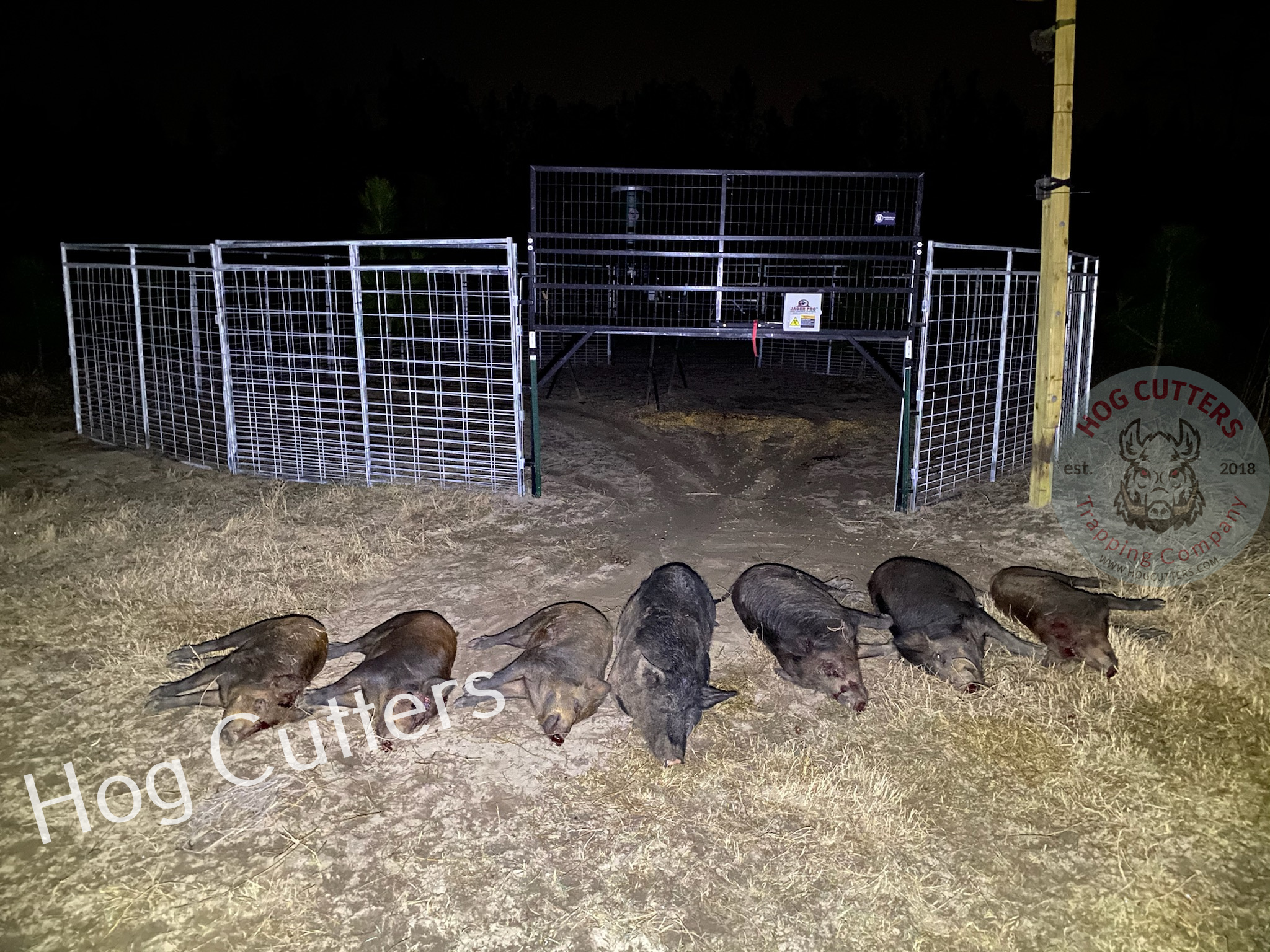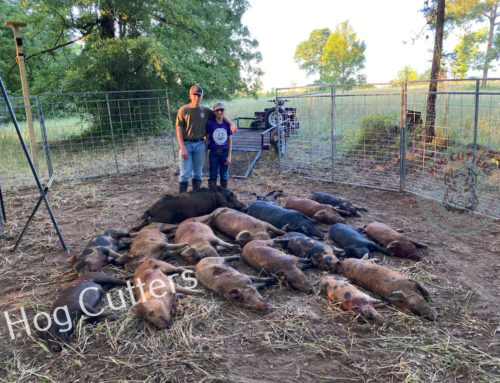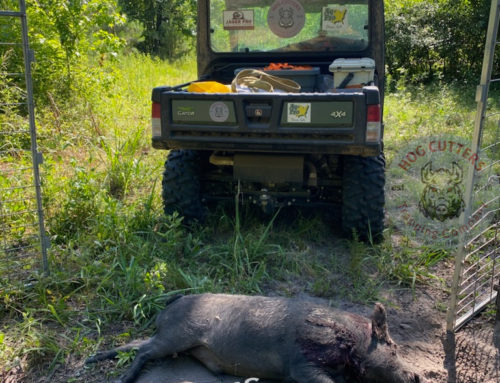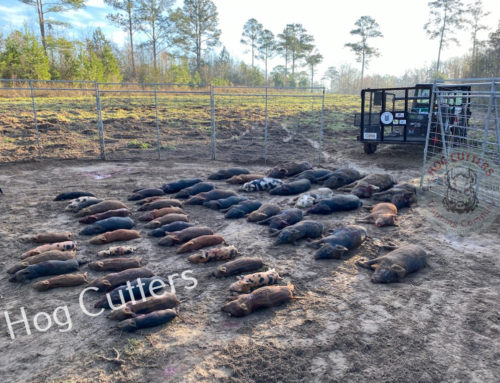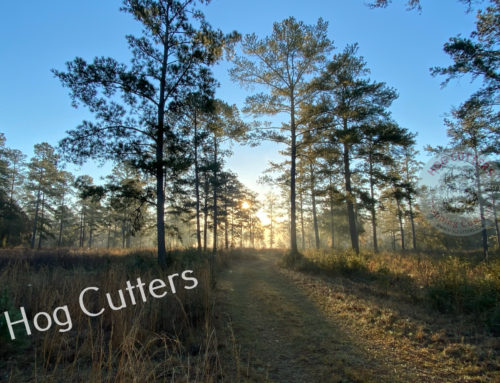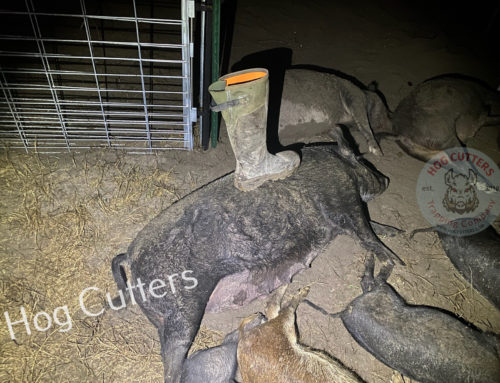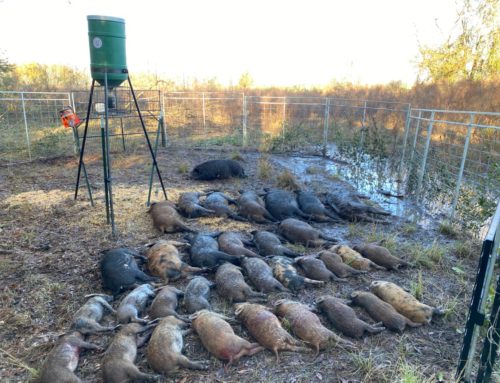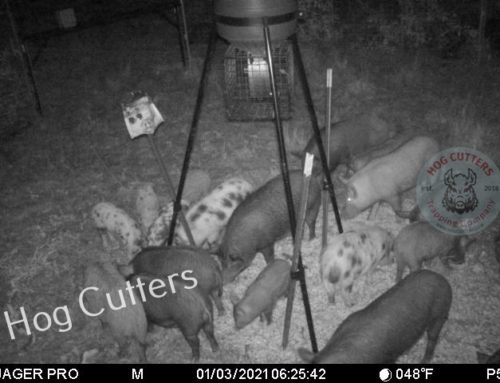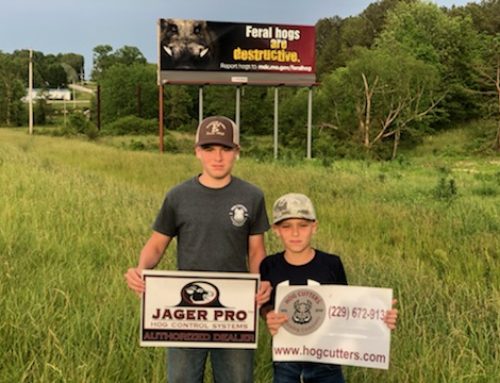Today’s post comes with a disclaimer: Hog Cutters provides professional feral hog trapping services. The tactics discussed in tonight’s post and the use of the methods we share, are not expectations held for “home trappers”. A lot level of time, planning, and resources went into executing the methods we used to successfully bring down a full family group, as well as additional hogs in the same field, without detriment to further operations at that location.
Our story begins in mid-January when Hog Cutters began a new hog trapping initiative on a farm in South Georgia. The Georgia crew began as they always do, by scouting with the landowner to determine travel corridors and areas used as the hog’s “bedroom”. Two bait sites were installed to begin ascertaining hog movements and population in the vicinity. The site farthest afield showed hog traffic, but never more than a pair or three hogs at one time. However, the bait site established along a field of winter wheat showed significant signs of life. Multiple groups were wreaking havoc on our farmer’s field. When the feeder was introduced their interest in the field continued. They simply seemed to incorporate the feeder into their regular path of destruction.
Watching the movements of the individual family groups and roaming boars in the field, it was apparent we were looking at a new situation for our team. The best way to describe the hog’s behavior is to compare it to family night at the local buffet restaurant. The same small groups would meander around the 100-acre field – when one group leaves the feeder, another would enter. They would rotate this way throughout the night. This interaction continued as the double gate trap was installed around the feeder. The hogs were completely comfortable with the new double-gate enclosure.
Our normal strategy to deal with more than 1 group visiting a trap consecutively, is to drop the gate on the group arriving closest to morning. (We determine this by logging the regular visitation times over a period of days or weeks.) This was not a possibility when the parade of hogs was practically non-stop all night. An early concern was the lack of urgency in the hogs. As we all know, wild hogs are among the most intelligent species on earth. They can understand and form intelligent decisions based on reactions to problems. Simple concepts of cause and effect. So many hogs feeding and having easy access to an ample supply of food allowed them to be casual feeders. There was no urgency to reach the food and fill up before it was finished off by others. Josey decided we should begin by partially limiting access to the trap by closing 1 of the 2 gates. The hogs seemed relatively calm and continued their buffet-line behavior.
Now we were faced with another dilemma. How can we effectively remove the hogs without educating those in the field to the dangers of the trap? Furthermore, how can we do this without chasing the hogs remaining outside, onto a neighbor’s property? The solution had to also allow us to return and eliminate the remaining hog groups for our client.
Josey and I discussed (what I like to call) the hog inventory. The various groups numbers and identifying marks as well as their time inside the trap feeding. He considered the location and described a plan he thought would answer our questions and allow us to do our job without causing problems for the future.
On a remarkably cold night for deep South Georgia, we went to work. (Albeit Josey was the one in the cold. I was lucky to be doing my part from a warm home in Kansas City.)
The plan was for Josey to position the truck and trailer a reasonable distance to the field, and bed down in his truck until the buffet line began. When the group we were looking for entered the trap and showed relaxed feeding behaviors, I would call him to action.
At 12:26 a.m. I phoned him with news of our group. He quickly loaded up his gear to make his way on foot. We were to stay in constant contact through his Bluetooth headset: I would provide regular updates with trap activity while he made the ½ mile trek to the field and began making entry.
As he hoped, Josey’s presence on the field alerted one nearby group of hogs and sent them scurrying into the woods. Scanning the field with the thermal scope, he spotted a heavy boar and began circling around his position. When firing was imminent, we would coordinate the gate drop with his rifle fire.
When I finally heard his footfalls go still, he asked if the trap was still looking good. At my agreement he gave the command to drop when ready. As I heard the distant thump of the gate hitting home, he whispered, “Contact.” The field boar dropped, and a group fled for the woods.

As hungry hogs will often do, another boar re-entered the area behind Josey. Even though the six in our trap were creating havoc by ramming panels, the boar returned to rooting the ground for leavings of the previous peanut harvest. The boar appeared unbothered by the ruckus in the trap, the previous boar’s death, or Josey’s presence in the field. He remained that way until a .308 round connected with his body. The boar somehow had enough adrenaline to pull himself into the wood line.
What seemed like an hour later, Josey approached the trap. We terminated our communication so Josey could get on with the normal trapping necessities.
At two-fifty in the morning I receive a text that he is back at the truck to grab the Gator, scrape ice from the windshield, and head back to empty and reset the trap. The farmer would be coming to the nearby woods to retrieve all the fallen hogs during his morning chores.

All in all, the plan took an expanded amount of time and dedication to find success. By creating a distraction of gunfire, and dropping the gate a second before firing, we avoided imprinting the fear of a trap on the hogs within view. Eight hogs were removed from the scenario, and the next evening we were delighted to see the feeding parade begin again in earnest.
While Josey is making rounds to the Hog Cutters locations in Missouri and Arkansas, and presenting a trap demonstration to the Poteau River Conservation District in Waldron, the trap will be regularly baited. We will continue monitoring the sites to determine how the remaining hogs re-assemble themselves. Thus far we have 2 family groups visiting the trap multiple times throughout the night, as well as another single boar. The ICE camera site continues to show a trio of hogs who seem unaffected by our activity in the trap area.
We will continue to keep you posted as we return to this South Georgia farm. If you have questions or need trap information, give us a call.

